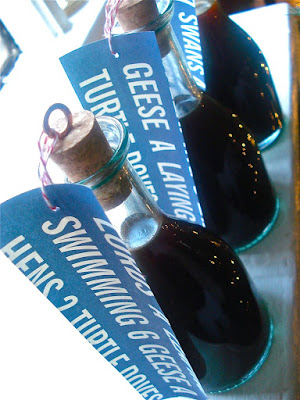
And I also decided to show my Christmas gratitude and pass out homemade liqueur to folks I don’t usually exchange gifts with. A way to say thank you, for being you. For being a wonderful presence in my life: and for sustaining the nuttiness. I soon realized I was limited in recipe yields only, running out of liqueur long before running out of people to share it with.
I made this espresso liqueur right around the time I made the cranberry cordial. Like the cordial, there isn’t much work involved. Just a fair amount of time straining out espresso grinds, if you aren’t paying attention and/or are lured by the sound of freshly ground organic espresso beans instead of the instant kind. Then you might spend, say, 2 hrs instead of 20 minutes in the kitchen.
Though I can’t speak for the original instant espresso version, my idiot-infused version came out an unctuous celebration of coffee and vanilla bean. It’s lovely with a heavy-handed splash of cream after dinner.
It also looked quite festive bottled and decked with "12 Days of Christmas" tags. The tags were a suitable addition; the song is one of my favorite holiday numbers, probably because it combines such a perplexing collection of extravagant peculiarities. (And who can’t relate to that during the holidays?)
Somehow the "12 Days of Christmas" manages to come off gilded and high-spirited, with no one questioning what exactly a partridge in a pear tree is doing in the company of leaping lords and golden rings (five?!). Similarly, this Christmas no one questioned the extraordinarily eclectic band of occurrences: which made this year one of my favorites.
So without further ado (at this juncture perhaps you can imagine 12 drummers drumming) …
My most very favorite 12 things from Christmas 2010:
Twelve boozy rum balls
Eleven minutes spent listening to The Polar Express on YouTube, as read by William Hurt
Ten homemade ravioli (a Doucette family Christmas Eve tradition)
Nine pieces of sour cherry pie: made and pitted by my Grandma Lee (using a paper clip as a cherry pitter)
Eight mentions of Marilyn Monroe, broads, and drinking before noon, from my Uncle John
Seven minutes spent laughing, after my 87 year-old grandmother told me I'd “been around the block” (the “right way,” she clarified)
Six new ways I can make pasta using my new KitchenAid attachment
Five times I thanked my grandma for giving me her vintage golden clutch
Four main ingredients needed for my great great Aunt Marion’s meatballs*
Three hours spend watching TLC's "Next Great Baker" with my mother and brother (and realizing I need to start using the signature sendoff from Buddy “the Cake Boss”: “Get in the box truck, baby”)
Two witnesses hearing “‘Twas the Night Before Christmas” sang to the tune of “Stairway to Heaven”
And a ... kind of Christmas that makes you cry from laughter
I hope you enjoyed your Christmas with family and friends to the fullest. And fully recommend starting the year of fresh, perhaps with a batch of espresso liqueur. It will be ready for you just in time to toast the last of your New Year’s resolutions away.









